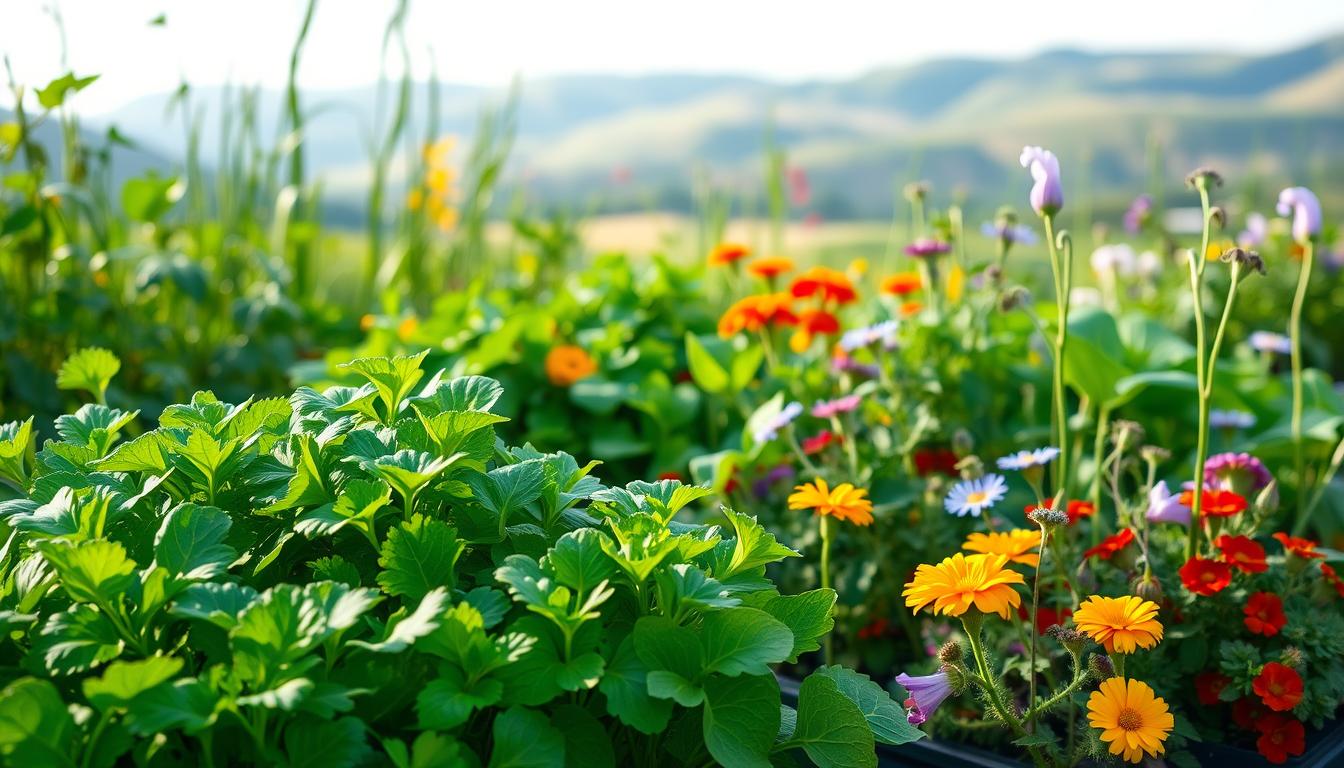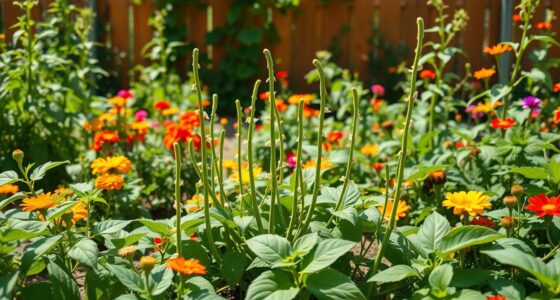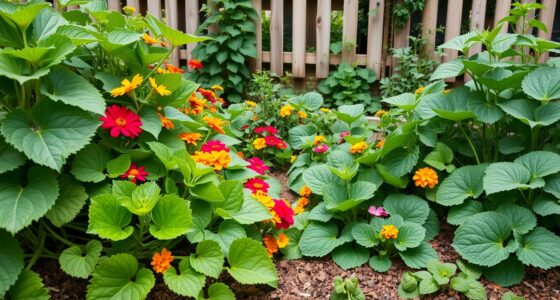As you stand in your garden, the earthy smell of fresh soil and the vibrant colors of your plants envelop you. You can’t help but feel a connection to the land, a sense of purpose with every seed you sow. Among these seeds, think about arugula — that peppery green delight you savor in salads and on gourmet pizzas. Arugula gardening is not just about nurturing a plant; it’s about cultivating a rich ecosystem that thrives around it. The right companion plants for arugula can enhance its growth, protect it from pests, and enrich its flavor. In this guide, we will explore the best plants to grow with arugula, ensuring that your garden flourishes like never before.
Key Takeaways
- Companion plants can enhance the growth and flavor of arugula.
- Understanding what to plant alongside arugula maximizes its health and yield.
- Certain plants naturally deter pests that may harm arugula.
- Spacing and layout are crucial for successful companion planting.
- Seasonal adjustments can optimize companion planting results.
Why Companion Planting Works for Arugula
When you think about enhancing your garden, companion planting for arugula opens a world of opportunities. By creating beneficial relationships between various plants, you can increase productivity and protect your crops from pests. In this section, we’ll explore the benefits of companion planting and understand how companions can affect the growth of arugula.
Benefits of Companion Planting
One of the most significant benefits of companion planting is the ability to boost plant health through diversity. By pairing arugula with compatible plants, you can enhance the growth of your crops. This method reduces the likelihood of disease and pest infestations while promoting a balanced ecosystem in your garden. When you introduce specific companions, you can:
- Attract pollinators that help with flowering and fruiting
- Repel harmful insects that might target arugula
- Encourage nutrient sharing among plants
How Companions Affect Growth
The interaction between arugula and its companions can lead to healthier plants and higher yields. Certain plants create microclimates that provide optimal conditions for growth, such as shade or moisture retention. This is vital for arugula, which thrives in cooler temperatures. Companions can:
- Improve soil health by contributing organic matter
- Reduce competition for nutrients, allowing arugula to flourish
- Enhance growth with companions that provide structural support or shade
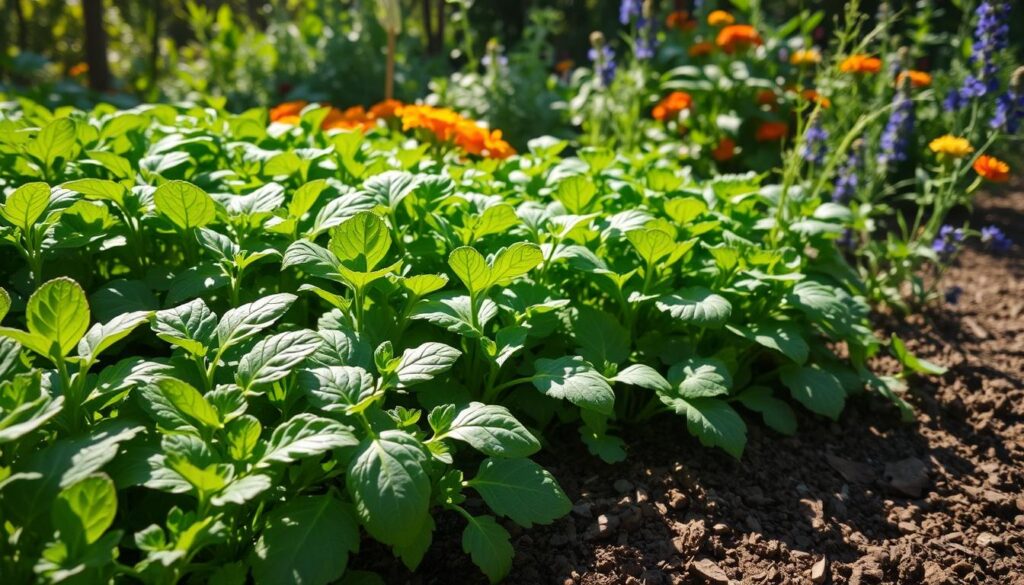
Ideal Companions for Arugula
Choosing the right plants can significantly enhance your arugula garden. The ideal companions for arugula serve various purposes, from attracting beneficial insects to deterring pests. Here are some of the best plants to grow with arugula that can elevate your garden’s health and productivity.
Nasturtiums: A Flavorful Match
Nasturtiums are not just visually appealing; they also act as trap crops. These vibrant flowers draw pests like aphids away from arugula, making them perfect partners in your planting strategy. Their peppery flavor complements arugula well, adding diversity to your culinary adventures.
Radishes: Fast Friends in the Garden
Radishes are among the best plants to grow with arugula due to their rapid growth and ability to aerate the soil. As they develop, radishes help create a healthier growing environment for your arugula, promoting robust leaf production. Their quick maturity allows you to enjoy them alongside your arugula harvest.
Marigolds: Pest Deterrents
Marigolds provide excellent protection for arugula garden companions. Known for their pest-repellent properties, these flowers help ward off nematodes and flea beetles, which frequently target arugula. By incorporating marigolds into your garden plan, you ensure a more resilient and thriving arugula crop.
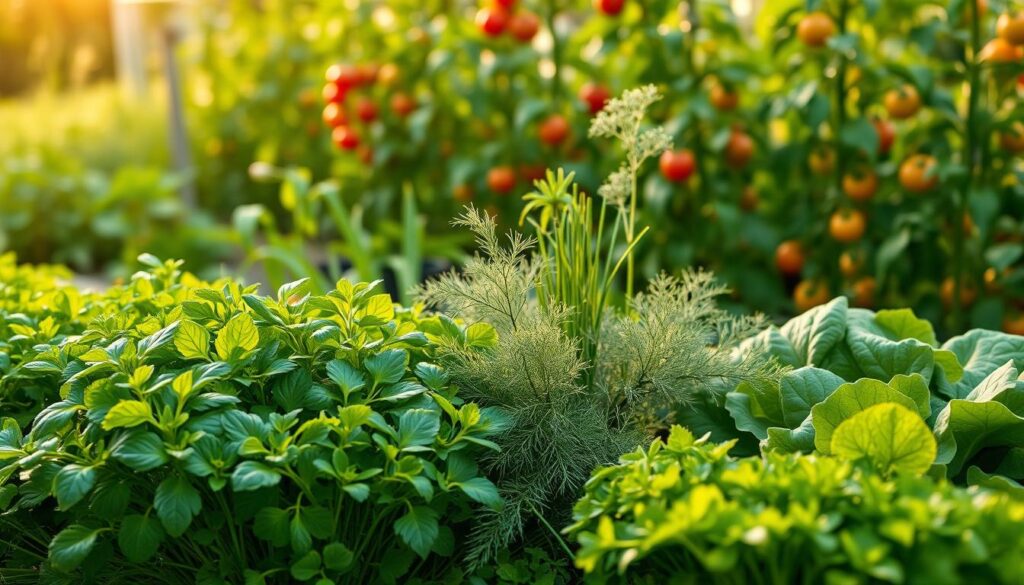
Plants to Avoid Near Arugula
When planning your garden, it’s crucial to recognize the plants to avoid near arugula. Certain species can negatively impact arugula’s growth by competing for nutrients or attracting pests. Steering clear of these bad neighbors for arugula can help ensure your arugula thrives in its growing environment.
Cabbage Family Members
Members of the cabbage family, such as cabbage, broccoli, and cauliflower, are significant culprits when it comes to incompatible plants. They vie for similar nutrients and can often attract common pests like aphids, which can become a problem for your arugula.
Strong-Scented Herbs
Herbs like dill can sometimes interfere with arugula’s growth despite their benefits in other contexts. These strong-scented herbs can dominate nutrient uptake and potentially stunt the growth of your arugula, making them bad neighbors for arugula.
Antagonistic Vegetables
Nightshades—including tomatoes and potatoes—are another group to avoid. These vegetables prefer acidic soil, which conflicts with arugula’s preference for neutral conditions. Introducing any of these incompatible plants can create challenges in your garden.
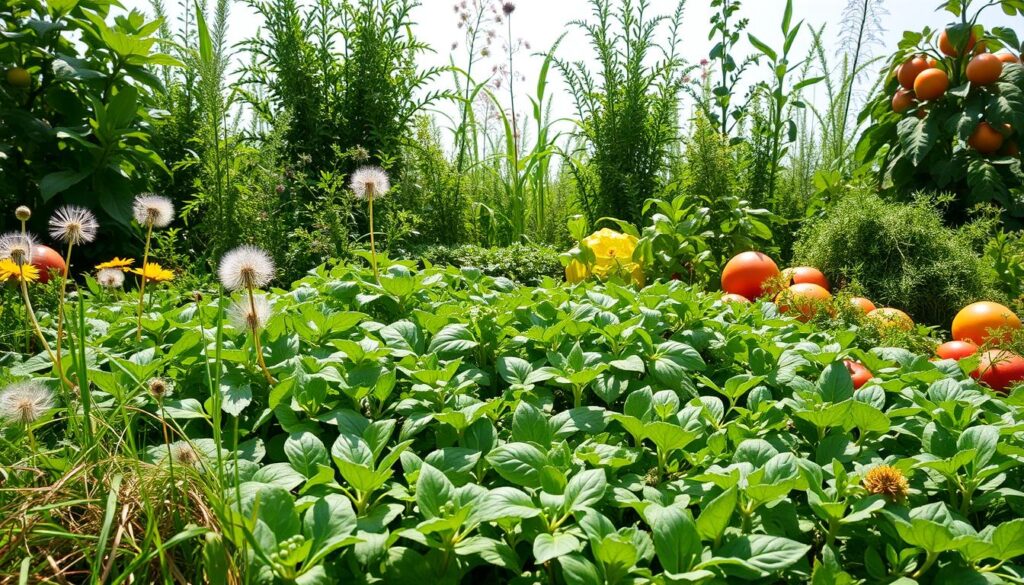
| Incompatible Plant Type | Reason to Avoid |
|---|---|
| Cabbage Family (Cabbage, Broccoli) | Compete for nutrients and attract pests |
| Strong-Scented Herbs (Dill) | May hinder arugula’s growth |
| Nightshades (Tomatoes, Potatoes) | Prefer acidic soil, conflicting with arugula’s needs |
Herbs That Thrive Alongside Arugula
Incorporating herbs that thrive with arugula can enhance your garden’s flavor and pest management capabilities. Two of the most notable arugula companion herbs are dill and basil. Both herbs not only coexist well with arugula but also elevate its culinary potential. Understanding their benefits can help you make informed planting decisions for a multifaceted and fruitful garden.
Dill: An Aromatic Companion
Dill stands out as a remarkable addition among arugula companion herbs. Its aromatic nature can deter pests, particularly flea beetles, which might attack your arugula. This natural pest management aspect ensures a healthier growing environment. In addition to its protective qualities, dill enhances the flavor profile of arugula, making your dishes even more delightful. By planting dill alongside arugula, you benefit from a dual advantage: pest control and flavor enhancement.
Basil: Enhancing Flavor Together
Basil complements arugula with its rich aroma and bold taste, contributing to an array of flavorful dishes. This pairing creates a delightful balance, giving your garden a culinary edge. Beyond flavor, basil acts as a deterrent for certain pests, helping to safeguard the arugula. When both herbs are grown together, they not only support each other’s growth but also promote a vibrant and aromatic garden atmosphere. Choosing basil as one of your flavor-enhancing companions will certainly elevate your gardening experience.
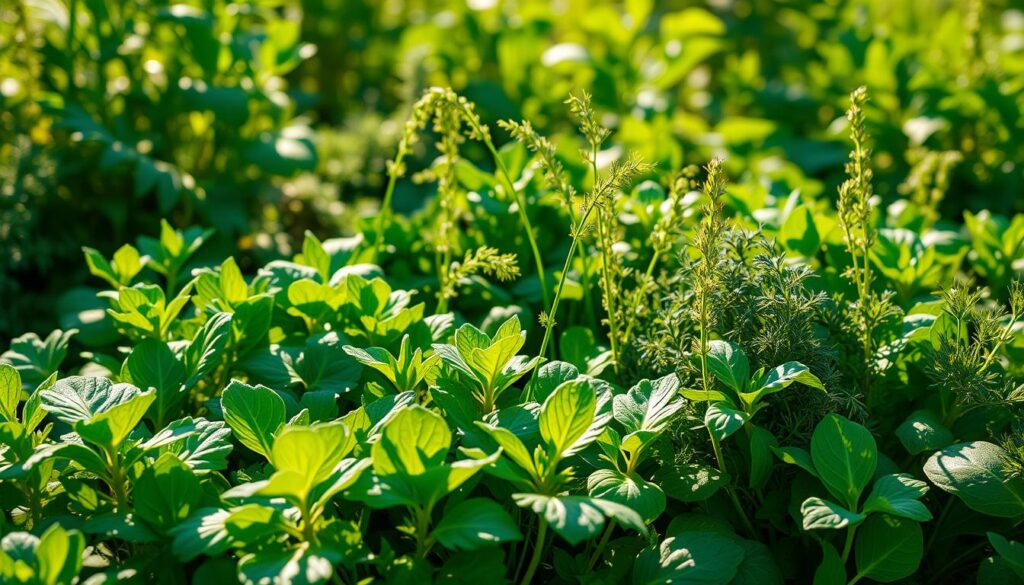
Vegetables That Pair Well with Arugula
When you’re planning your garden, selecting the right vegetables that pair with arugula can maximize your space and enhance the flavor of your harvest. Incorporating the best companion vegetables for arugula, such as cucumbers and peppers, will create a thriving growing environment. These choices can boost the overall health and productivity of your arugula garden vegetables.
Cucumbers: A Refreshing Duo
Cucumber plants provide excellent ground cover, helping to reduce weed competition and retain soil moisture. Along with thriving in similar conditions as arugula, they make efficient use of garden space with their sprawling growth habit. This pairing allows for a more productive garden layout, creating a fresh and nutritious harvest.
Peppers: The Perfect Spice
Peppers not only share sunlight requirements with arugula, but they also elevate the flavor of your culinary creations. Growing peppers alongside arugula introduces a delightful contrast of spices in your dishes. This combination not only benefits your meals but supports diverse garden health. As you explore the best companion vegetables for arugula, don’t overlook the vibrant contributions of peppers.
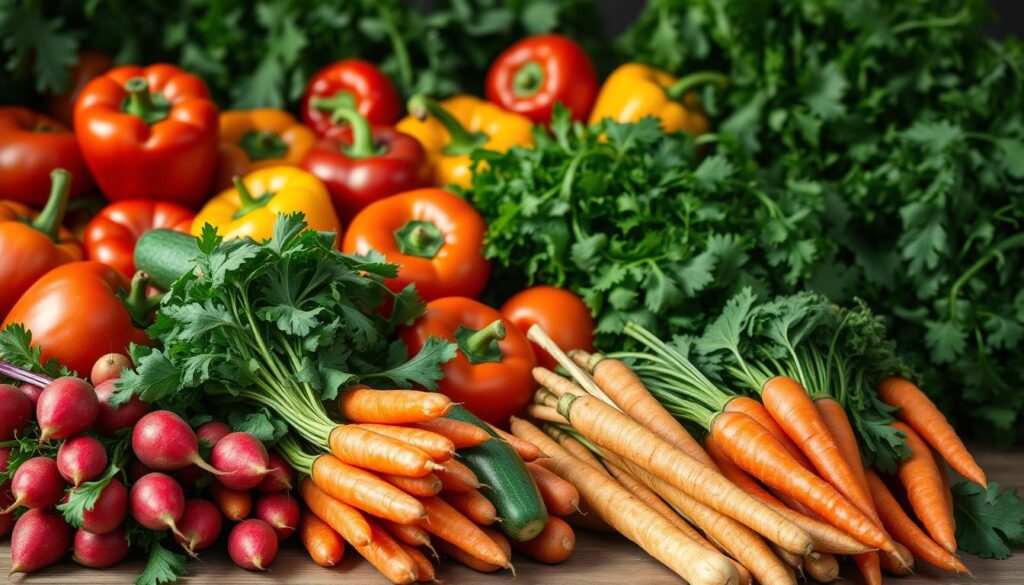
| Vegetable | Benefits | Growth Compatibility |
|---|---|---|
| Cucumbers | Reduces weeds, maintains soil moisture | Thrives in similar conditions as arugula |
| Peppers | Enhances flavor profile | Shares sunlight and growth conditions |
How to Plan Your Companion Planting Layout
Effective planning is essential for successful companion planting, especially with arugula. When creating your arugula planting layout, consider strategically grouping plants that thrive together. These companion planting strategies not only enhance growth but also improve nutrient availability in your garden.
Companion Planting Strategies
Grouping plants based on their growth patterns and specific needs promotes a flourishing ecosystem in your garden. For instance, using taller plants to provide shelter can create a microclimate that benefits arugula, reducing the chances of bolting in warmer weather. Choosing fast-growing companions can help mark spaces for slower growers, ensuring you avoid overcrowding while allowing optimal plant spacing for each variety.
Spacing for Optimal Growth
Maintaining appropriate distances between your arugula plants is crucial, as proper spacing allows for better air circulation and sunlight exposure. Aim for a spacing of about 4-6 inches between each arugula plant. This optimal plant spacing fosters healthier growth and makes it easier to manage weeds and pests around your garden layout.
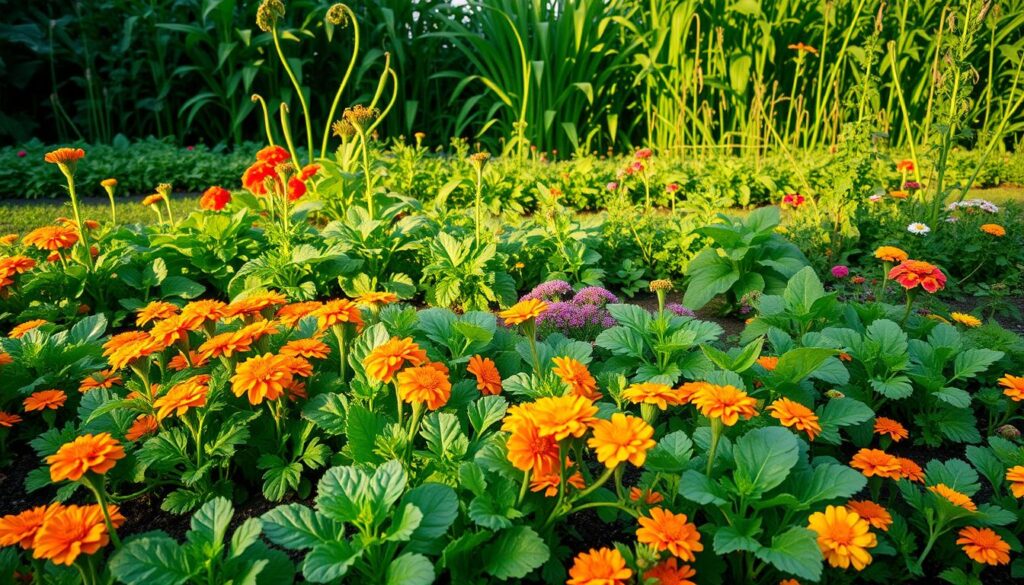
Timing for Planting Arugula and Companions
Understanding the optimal timings for planting arugula and its companions can significantly enhance your gardening experience. The right planting schedule for arugula ensures you reap the benefits of fresh greens throughout the year. Knowing the best seasons for arugula helps you to strategically plan your garden, ensuring maximum yield.
Best Seasons for Planting
Arugula thrives in cooler conditions, making early spring and mid to late summer the best seasons for planting. This leafy green flourishes before the frost in spring and can be harvested again in fall if planted in mid-summer. Timing your sowing according to these seasons allows for staggered plantings, promoting a continual harvest of this nutritious vegetable.
Timing for Companion Seeds
When considering the timing for companion planting, synchronized planting of arugula and its companions maximizes their growth potential. Starting companion seeds at the same time as arugula creates a balanced ecosystem in your garden. For instance, pairing arugula with fast-growing companions, such as radishes, allows for efficient use of space and resources. Ensuring that both plants are sown together can lead to enhanced growth and a more fruitful garden.
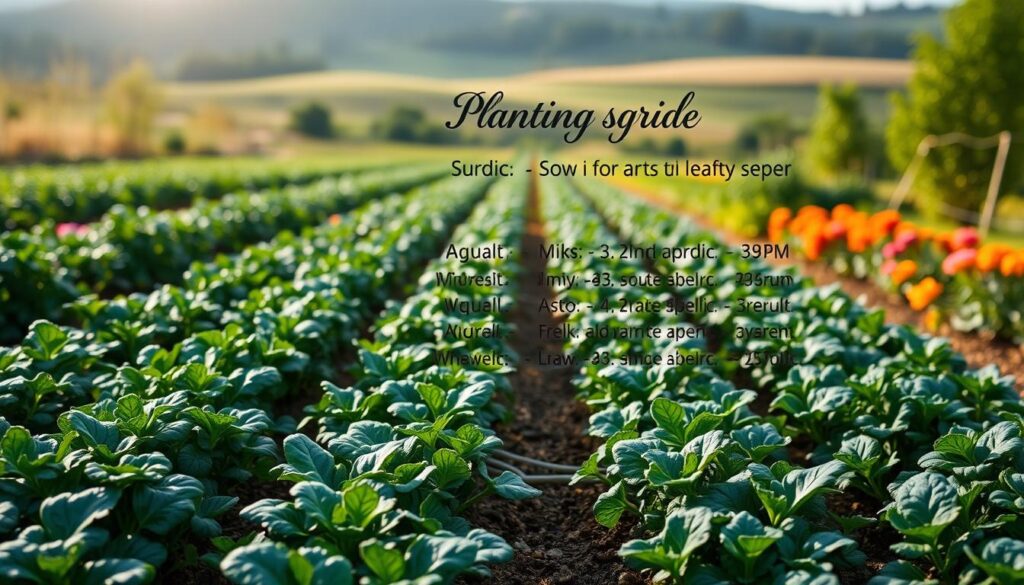
| Season | Arugula Planting | Companion Planting Suggestions |
|---|---|---|
| Early Spring | Direct sow arugula seeds | Nasturtiums, Radishes |
| Mid-Summer | Direct sow arugula seeds for fall harvest | Marigolds, Spinach |
Nutrient Requirements for Arugula and Companions
Understanding the nutrient needs for arugula and its companions lays the foundation for a thriving garden. Arugula flourishes when planted in nutrient-rich, well-drained soil, ideally with a pH of 6.5-7. Maintaining soil health for arugula is essential not just for its growth but also for the health of neighboring plants. By incorporating organic matter, you can enhance soil structure and fertility.
Soil Health Considerations
Soil health directly influences plant vitality. For arugula, ensuring high organic content supports nutrient retention and drainage. Regularly adding compost or well-rotted manure can significantly improve soil structure, making it more conducive for healthy root development. This focus on soil promotes not only arugula’s growth but also benefits companions like beans, which contribute to improved nitrogen levels.
Fertilizer Choices
Selecting the right fertilizer options for arugula is essential for sustaining its growth cycle. Balanced fertilizers or organic compost provide a steady nutrient supply. Nitrogen, phosphorus, and potassium are crucial, especially for vigorous phases of growth. Pay particular attention to the needs of your companion plants, as some, like legumes, can enrich the soil naturally, helping maintain the nutrient balance for your arugula.
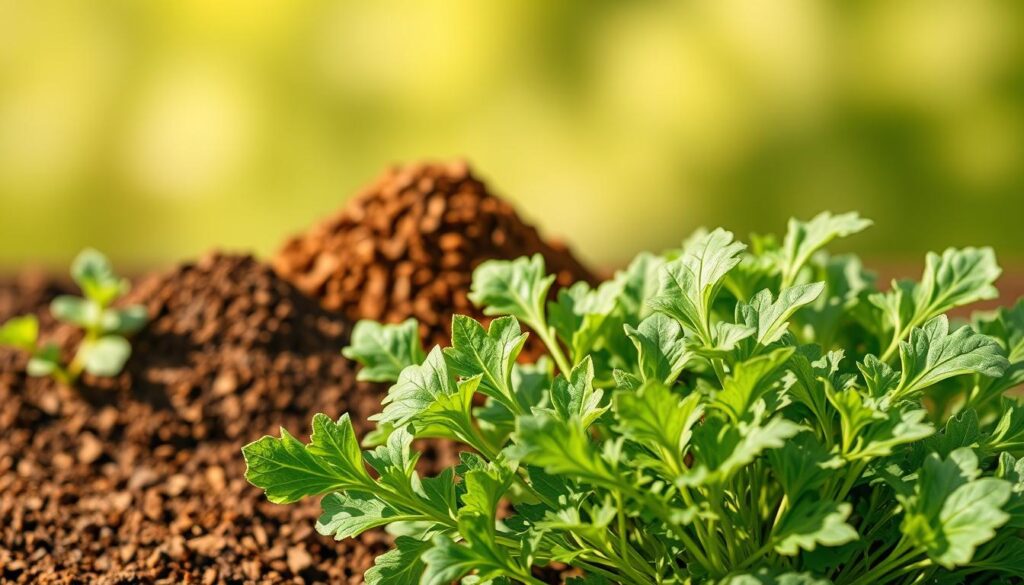
| Fertilizer Type | Key Nutrients | Benefits |
|---|---|---|
| Balanced Fertilizer | Nitrogen, Phosphorus, Potassium | Supports overall plant health and promotes robust growth |
| Organic Compost | Varied Nutrients | Enhances soil structure and promotes beneficial microorganisms |
| Fish Emulsion | Nitrogen | Stimulates vigorous leaf growth |
| Bone Meal | Phosphorus | Helps in root development and flowering |
Pest Management with Companion Plants
Pest management for arugula becomes a more natural and effective process when utilizing companion plants for pest control. By fostering a balanced ecosystem in your garden, you can attract beneficial insects that naturally reduce pest populations and enhance your arugula’s health. Understanding which plants to introduce can lead to a more flourishing garden and a bountiful harvest.
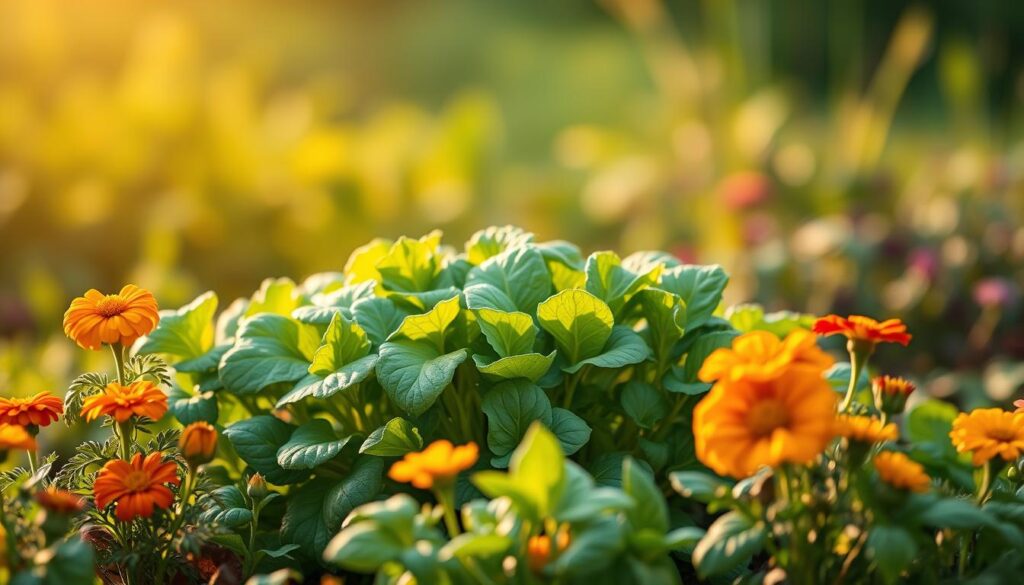
Attracting Beneficial Insects
Incorporating specific companion plants encourages beneficial insects in the garden, such as ladybugs and lacewings. These insects prey on common arugula pests like aphids and caterpillars. For instance, planting flowers like yarrow or dill will invite these helpful allies to your garden. Their presence will significantly support pest management for arugula, allowing you to maintain a healthy growing environment.
Natural Pest Repellents
Certain plants serve as natural repellents, helping deter unwanted pests. Marigolds are widely recognized for their ability to repel nematodes and other harmful insects. Nasturtiums, with their peppery leaves and flowers, can act as trap crops, luring pests away from your arugula. Utilizing these companion plants for pest control not only protects your crops but also enriches the biodiversity of your garden.
Watering Needs of Arugula and Its Companions
Understanding the watering needs for arugula is crucial for a successful garden. Proper hydration not only supports arugula’s growth but also benefits its companion plants. Establishing a consistent watering schedule for companion plants helps maintain the health and productivity of your garden.
Watering Schedule for Success
Arugula thrives in consistently moist soil, especially during the spring and fall. A recommended approach is to water your plants when the top inch of soil feels dry to the touch. During dry spells, aim for deep, infrequent waterings to encourage deeper root growth. Keep an eye on your watering schedule for companion plants to ensure they receive adequate moisture without pushing plants to saturation.
Monitoring Soil Moisture
Effective soil moisture management is essential in maintaining the balance required for healthy growth. Utilizing a moisture meter can provide valuable insights into the soil’s moisture levels, allowing you to tailor your watering routine effectively. Regular monitoring helps you determine when it is time to water, preventing both underwatering and overwatering situations, which can adversely affect both arugula and its companion plants.
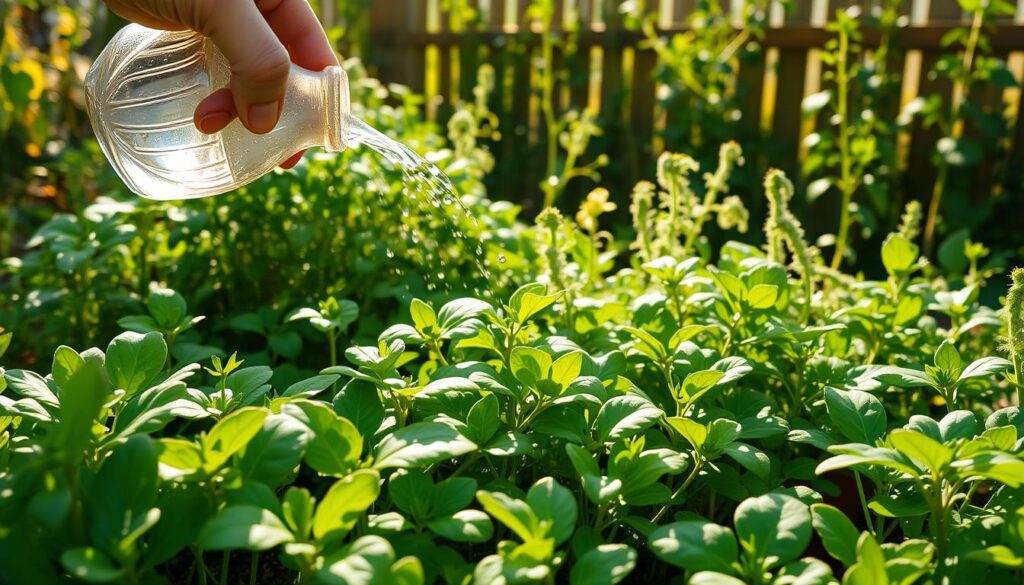
| Watering Technique | Benefits | Recommended Frequency |
|---|---|---|
| Top-soil Check | Ensures soil is not too dry or wet | Every 2-3 days |
| Deep Watering | Encourages deep root growth | Once a week |
| Moisture Meter Use | Accurate soil moisture level readings | As needed |
Harvesting Tips for Arugula and Companions
Successfully harvesting your crops requires attention to timing and method. Knowing when to harvest is crucial for maximizing flavor and yield. This section will explore harvesting arugula tips and the right moments to pick companion plants to complement your meals.
When to Harvest Arugula
Typically, arugula can be harvested around 30 days after planting. The best time to do so is when the leaves are young and tender, ideally no longer than 5-6 inches in length. Using this arugula harvesting guide, you can enjoy the peppery flavor that fresh arugula provides. Check the leaves regularly, as they can become bitter if left too long.
Harvesting Companions Simultaneously
Many companion plants grow at similar rates, allowing you to harvest them together with your arugula. For example, plants like spinach and lettuce often reach maturity around the same time. This helps you take advantage of your garden’s yield without disrupting arugula growth. Knowing when to harvest companion plants can create delicious salads with minimal effort and maximize your gardening success.
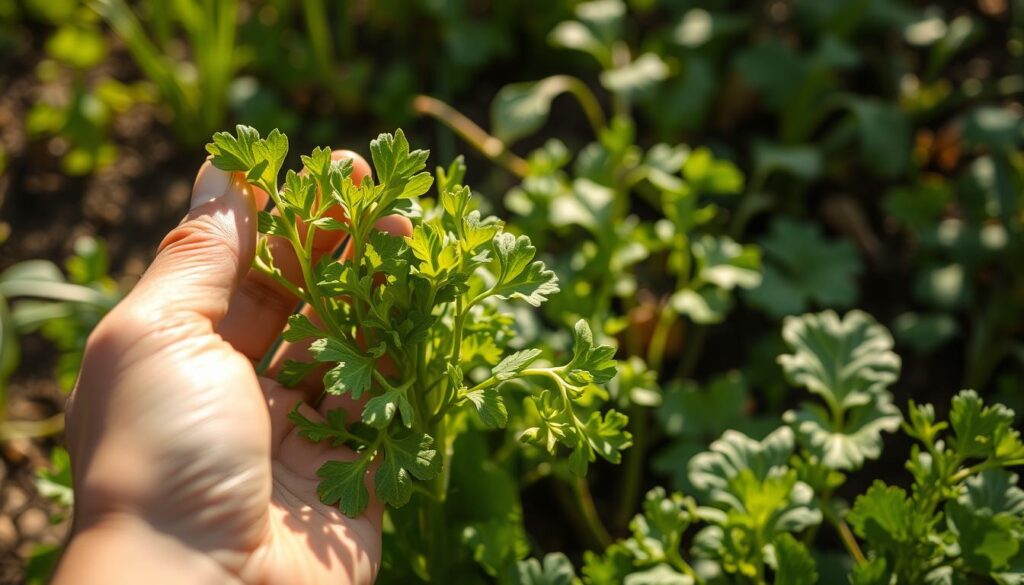
Seasonal Companion Planting Adjustments
Adjusting your planting strategies with the seasons can make a significant impact on your garden’s productivity. The right seasonal companion planting can optimize growth and enhance yields in both spring and fall. Utilizing a thoughtful spring planting guide can help you select the most compatible crops for arugula during the cooler months. As you transition into fall, implementing effective fall garden strategies will ensure your garden remains productive as the weather changes.
Spring Planting Strategies
In spring, focus on pairing arugula with cool-weather crops that thrive in the milder temperatures. Choose companions such as:
- Peas: These enrich the soil, making nutrients available for arugula.
- Lettuce: Both enjoy similar growing conditions and maximize your garden space.
- Spinach: Shares similar sunlight and moisture needs, promoting healthier growth.
These combinations can lead to a flourishing garden, ensuring you take full advantage of the spring planting season.
Fall Companion Choices
As fall approaches, you may want to introduce fast-growing crops like radishes. These can be planted alongside arugula for an efficient harvest. Consider nitrogen-fixing plants such as:
- Clovers: They enhance soil health and prepare it for winter.
- Bush beans: These provide nutrients and can be harvested before the first frost.
Incorporating these choices into your fall garden strategies will help maintain soil vitality and ensure a bountiful end-of-season yield.
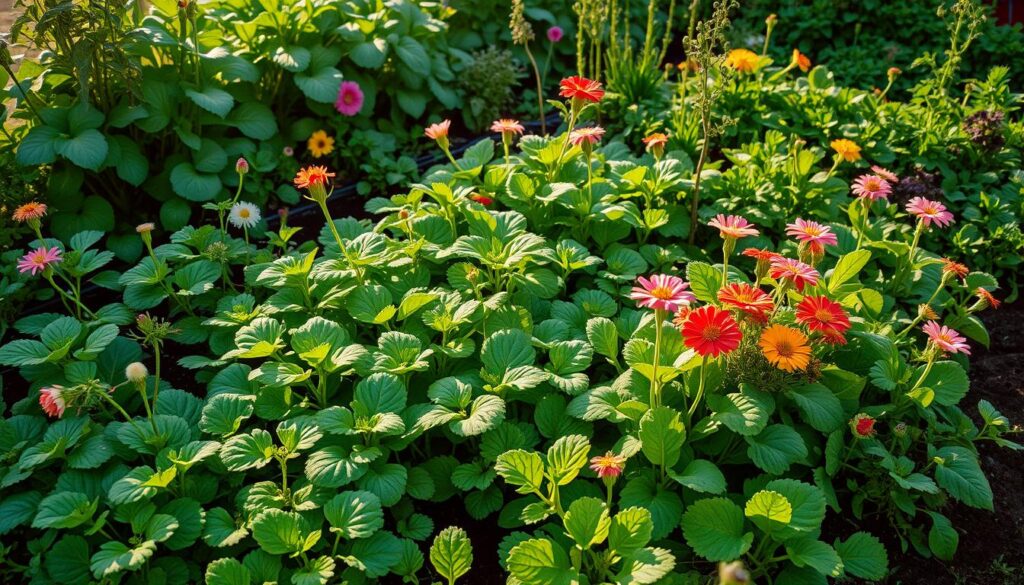
Using Companion Plants to Enhance Flavor
Companion planting offers great opportunities to enhance flavor with companion planting, especially with arugula. Surrounding this peppery green with specific herbs and vegetables not only creates a harmonious growing environment but also contributes to its overall flavor profile. Exploring co-growing benefits can be incredibly rewarding for both your palate and your garden.
Taste Benefits of Co-Growing
When you grow arugula alongside complementary plants such as basil and dill, the taste of your dishes can significantly improve. These herbs not only thrive but also work synergistically with arugula, creating a more complex and enjoyable flavor combination. Tasting these harmonious mixtures allows you to uncover new dimensions of flavor that can elevate your culinary creations. The right companions can add zest and enhance flavors, making you enjoy your meals even more.
Culinary Combinations to Try
Experimenting with various culinary uses for arugula companions is a joyful aspect of gardening. Consider these delightful combinations:
- Arugula and Basil Pesto: Blend fresh arugula with basil, garlic, nuts, and olive oil for a unique twist on a classic sauce.
- Arugula Salad with Dill Dressing: Toss arugula with yogurt, dill, and lemon juice for a refreshing salad dressing.
- Roasted Vegetables with Arugula: Pair roasted beets or carrots with fresh arugula and a dill vinaigrette for an exquisite side dish.
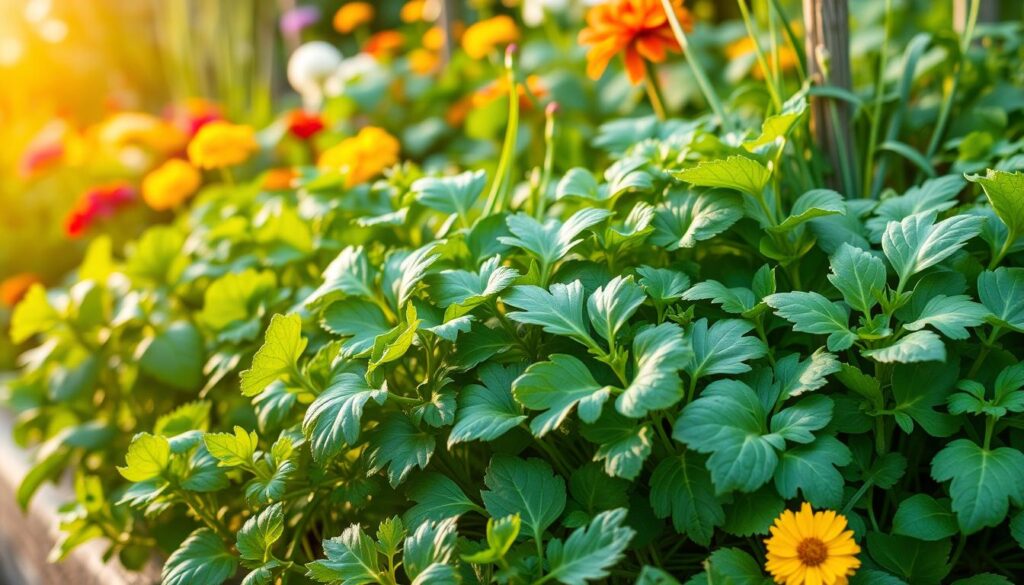
Troubleshooting Common Issues in Companion Planting
When engaging in companion planting with arugula, awareness of potential problems can significantly enhance your gardening success. Troubleshooting arugula plants often involves recognizing common growth issues that may arise from various factors. Early detection plays a crucial role in mitigating damage and ensuring a thriving garden.
Identifying Growth Problems
Begin by keeping an eye on your plants for signs that indicate something isn’t right. Watch for:
- Yellowing leaves, which can signal nutrient deficiencies
- Wilting or stunted growth, possibly due to overcrowding or competition for resources
- Pest infestations such as aphids or caterpillars that adversely affect growth
By familiarizing yourself with these issues, you can proactively address them and maintain a healthy garden environment.
Solutions for Unruly Companions
Once you’ve identified specific problems, applying solutions for companion planting challenges can lead to improvements. Consider these strategies:
- Removing any struggling plants that compete for space or nutrients with your arugula
- Adjusting the layout of your garden to provide adequate spacing, allowing for better air circulation and sunlight exposure
- Incorporating beneficial insects or natural pest repellents to manage pests
Regular maintenance and continuous monitoring of your planting conditions can ensure that your arugula and its companions flourish together.
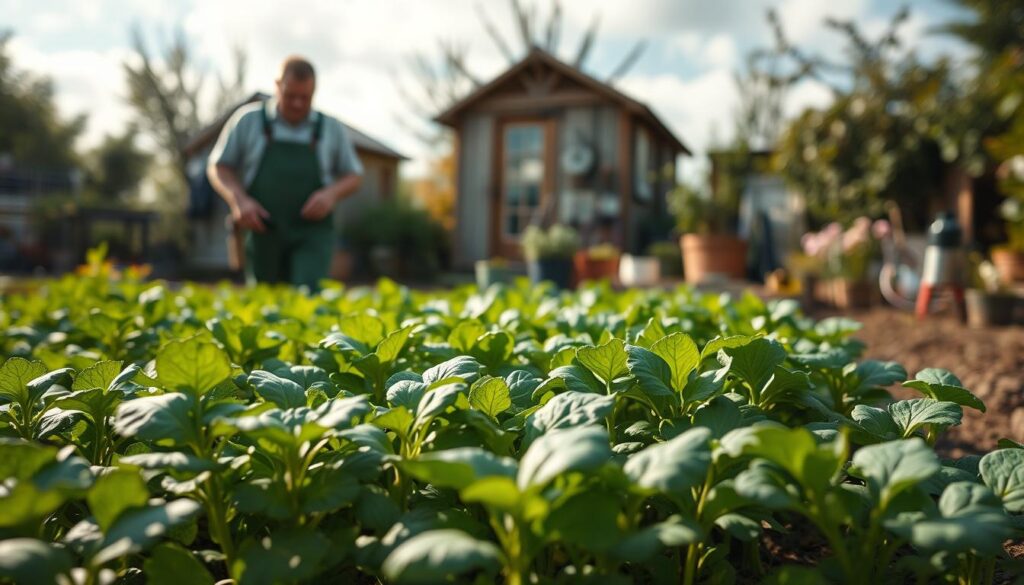
Conclusion: Your Own Companion Planting Adventure
As you embrace your gardening journey with arugula, it’s essential to remember that companion planting is a process of discovery and creativity. Engaging in this practice not only enhances the flavors and health of your crops but also enriches your overall gardening experience. By experimenting with different companion plants, you can create a thriving ecosystem in your garden that suits your unique conditions.
Continuing Your Gardening Journey
To build on your companion planting experience, consider keeping a garden journal for plant companions. Documenting the interactions between different species and noting which combinations thrive can lead to valuable insights for future planting seasons. By recording your observations, you can reflect on what works well and make informed adjustments to improve productivity in subsequent years.
Keeping a Garden Journal for Companion Planting
Your garden journal can also serve as a creative outlet where you can jot down favorite recipes or culinary combinations that feature your garden’s yield. This not only enhances your gardening journey with arugula but also fosters a deeper connection to the food you grow. Over time, you’ll develop a personalized roadmap of effective strategies tailored to your taste, ensuring your companion planting experience is both rewarding and delicious.
